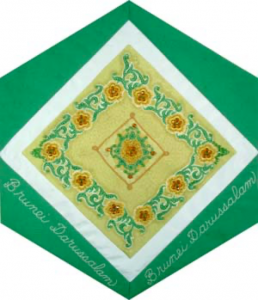Brunei Darussalam

The Block
The block was designed and stitched by Avy Loftus, a visual artist and batik designer. The block’s main attraction is the beautiful and exotic Bunga Simpor, Brunei’s national flower. The Simpor design is a common design used in traditional Brunei crafts such as weaving. It was stitched using amber-coloured beads against a lemon-green, silk batik background. The flowering tree metaphorically captures the resiliency of the country and its people. The flower, like Bruneians, is strong and hardy enough to grow and survive anywhere.
Cultural Profile
Brunei, a small constitutional sultanate lying along the coast of the South China Sea, is separated into two by Malaysia’s Sarawak province. Its name, Brunei Darussalam means “Abode of Peace.” Warm temperatures coupled with large amounts of rain have resulted in dense tropical rainforests––home to many species of plant and wildlife––covering about three-quarters of this rugged, hilly nation. Less than 15% of the country is used for agricultural purposes, which means that most produce must be imported. To ensure an adequate supply of beef, Brunei owns a cattle ranch, Willeroo, in the Northern Territory of Australia that is actually larger than the country itself. Brunei is a major exporter of petroleum and natural gas, which has resulted in it having one of the highest standards of living in Southeast Asia. Residents live tax-free and healthcare and education are also provided free-of-charge. The majority of people speak the official language, Malay, but Chinese and English are also widely used, reflecting Brunei’s ethnic make-up of Malay, Chinese and indigenous groups.
Tradition and custom are extremely important to the Bruneian people, who share the cultural traits of those living in the Malay Peninsula. Customary law, Adat, outlines rules and procedures for many cultural ceremonies and there is even a government department whose mandate is to preserve ceremonial procedures and advise on protocol, proper dress and genealogies. Family is also very important to Bruneians: it is at the center of the social structure of the country and includes every member of the extended family. Children are taught at an early age to respect their elders.
In 1975, the Brunei government set up the Arts and Handicraft Centre to preserve traditional crafts that were in danger of disappearing. The centre’s work has since sparked greater interest in, and a revival of the ancient traditions of silver- and brass-smithing, woodcarving, basketry and Songkok (hat or cap)-making. Weaving, a craft dating back many centuries in Brunei, also produces colourful cloth such as the prized Jong sarat used in wedding ceremonies, or the sinjang, used to make the men’s short sarongs is also taught at the center.
Brunei’s traditional music includes the adai-adai, songs sung as a group while people are working. They talk about life in the fishing villages and are usually accompanied by dance movements inspired by the common activities involved in fishing such as using an oar. The ceremonial aduk-aduk song and dance, meanwhile, is performed by groups on special occasion. The dancers are dressed as warriors and use coconut shells and drums for rhythm. Traditional instruments include the two-headed kendang drums, the rebana, a tambourine, and the kulintangs, metal gongs cast using the lost wax process.
Bruneians have only been coming to live in Canada within the last 30-40 years and to date, over four thousand Bruneian immigrants now call Canada home. Most have become associated with the Indonesian and Malaysian communities that share many of their cultural practices.
Sponsor: Jay and Nancy Woollven
